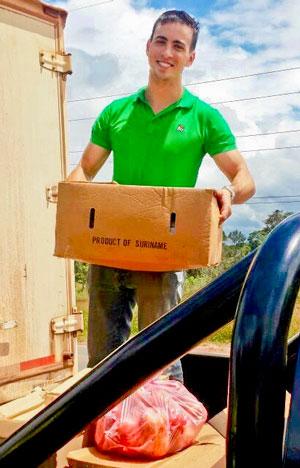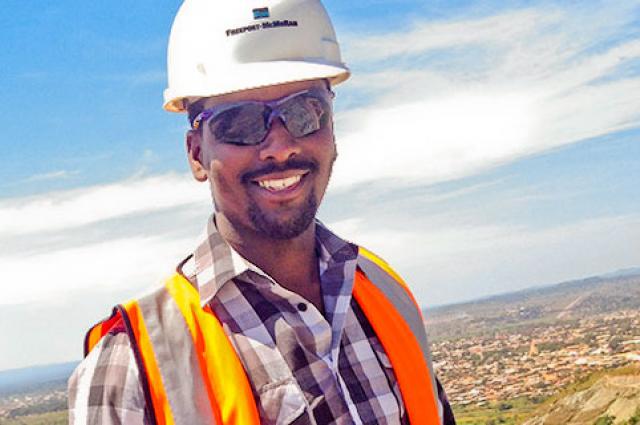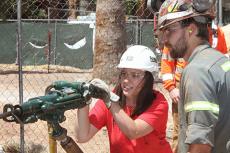UA Mining Engineering Internships Open Doors to Professional Success
The mining industry spans the globe, as do alumni of the University of Arizona mining and geological engineering program. Many got their feet wet working as interns for Arizona-based mining companies like Freeport-McMoRan.
Andrew DeSantola and Brian Njenga, friends from the Class of 2014, are two who transformed their internships into full-time jobs as mine engineers working on international projects.
Since earning his bachelor’s degree in mining engineering, DeSantola has worked for IAMGOLD Corp. -- first in South America, more recently in West Africa.
He credits the UA mining engineering program with helping him get internships at Arizona-based mining companies ASARCO and Freeport-McMoRan and at the Australia- and United Kingdom-based Rio Tinto -- jobs that helped launch his international career.
“I’ve always been interested in business, and mining engineering joins business strategy directly with engineering,” said DeSantola, from Bala Cynwyd, Pennsylvania. “What you mine and how you mine it are multimillion-dollar decisions; it is primarily mine engineers who are driving the business plan. I thought that was really cool.”
DeSantola interned for three semesters at Freeport-McMoRan at its central mine planning offices in Oro Valley, Arizona, north of Tucson, doing strategic and long-range planning for the company’s Tenke Fungurume mine in the Democratic Republic of the Congo.
“I had seen all the cool work that Freeport’s engineers had done abroad, and it made me want to be an expat engineer,” he said.
During his senior year in college, Canada-based IAMGOLD -- which does not operate mines in the United States -- sent recruiters from Toronto to the UA campus. Six interviews later, on the top floor of a Toronto skyscraper, company executives offered DeSantola a job as a mine engineer.
He began in a three-year global rotational leadership program, spending more than a year at the Rosebel open-pit gold mine in Suriname, a former Dutch colony on the northeastern Atlantic coast of South America.
“I did everything from operations management to life-of-mine planning, to rolling out mesh Wi-Fi network coverage in the jungle,” he said. “Weekends were spent macheting through the jungle, immersing myself in the local culture, eating lots of couscous and learning the local creole language of Sranan Tongo.”
DeSantola also participated in community service, delivering food in a region where most people live in villages accessible only by boat.

DeSantola then transferred to the company’s Essakane open-pit gold mine in the northern desert region of Burkina Faso, where he continues to work. The mine operates exclusively in French, which DeSantola learned in a three-week crash-course in Quebec before his transfer. He commutes to his job by light aircraft and works 12-hour days for 30 days straight, in hot and dusty conditions with temperatures that can exceed 120 degrees Fahrenheit.
“I have a hand in planning the largest investment in the history of Burkina Faso, one of the world’s 10 least-developed countries, but one whose economy is growing rapidly with the advent of western-style mining,” he said.
DeSantola will begin the final leg of his training in February 2017 at IAMGOLD’s Westwood mine in Quebec, which has a shaft over a mile deep.
“The UA department of mining and geological engineering has given me career opportunities to both see the world and have a major impact on it,” he said. “Without a doubt, joining the department was one of the best decisions of my life.”
Brian Njenga got to know DeSantola when they were freshmen living in the UA’s Arizona-Sonora dormitory. They took classes in chemistry and physics together and finished their programs as interns at Freeport-McMoRan’s Oro Valley offices, planning the Tenke Fungurume mine.
Njenga, who lived in Nairobi, Kenya, before moving to Minnesota at age 10, always knew he wanted to work on sustainable resource development in Africa.
“Mining was my gateway to get involved on the continent. My goal has always been to amass as much international experience as possible, especially in Africa, generally considered the new frontier in mining,” he said.
Njenga interned at Hexagon Mining as well as Freeport-McMoRan and met recruiters from both Arizona-based companies at UA career fairs.
“I cannot stress how my internships, particularly the experience with mine-planning software, prepared me for my current role,” he said. “I built my proficiency with the different packages and applications used every day in the real world. As a result, my transition into mine planning was quite smooth.”
After earning his bachelor’s in mining engineering, Njenga spent six months working as a drill and blast engineer at the Tenke Fungurume mine in shifts of eight weeks on and two weeks off. Today he is based at Freeport-McMoRan’s Oro Valley offices, where he continues to work on Tenke Fungurume-related projects and spends up to half the year in the Congo at the mine.
“It is very rewarding to see a design through to its execution,” he said. “I love to get my hard hat dirty and my boots muddy.”



